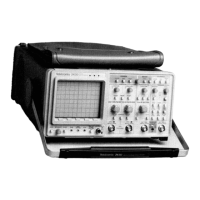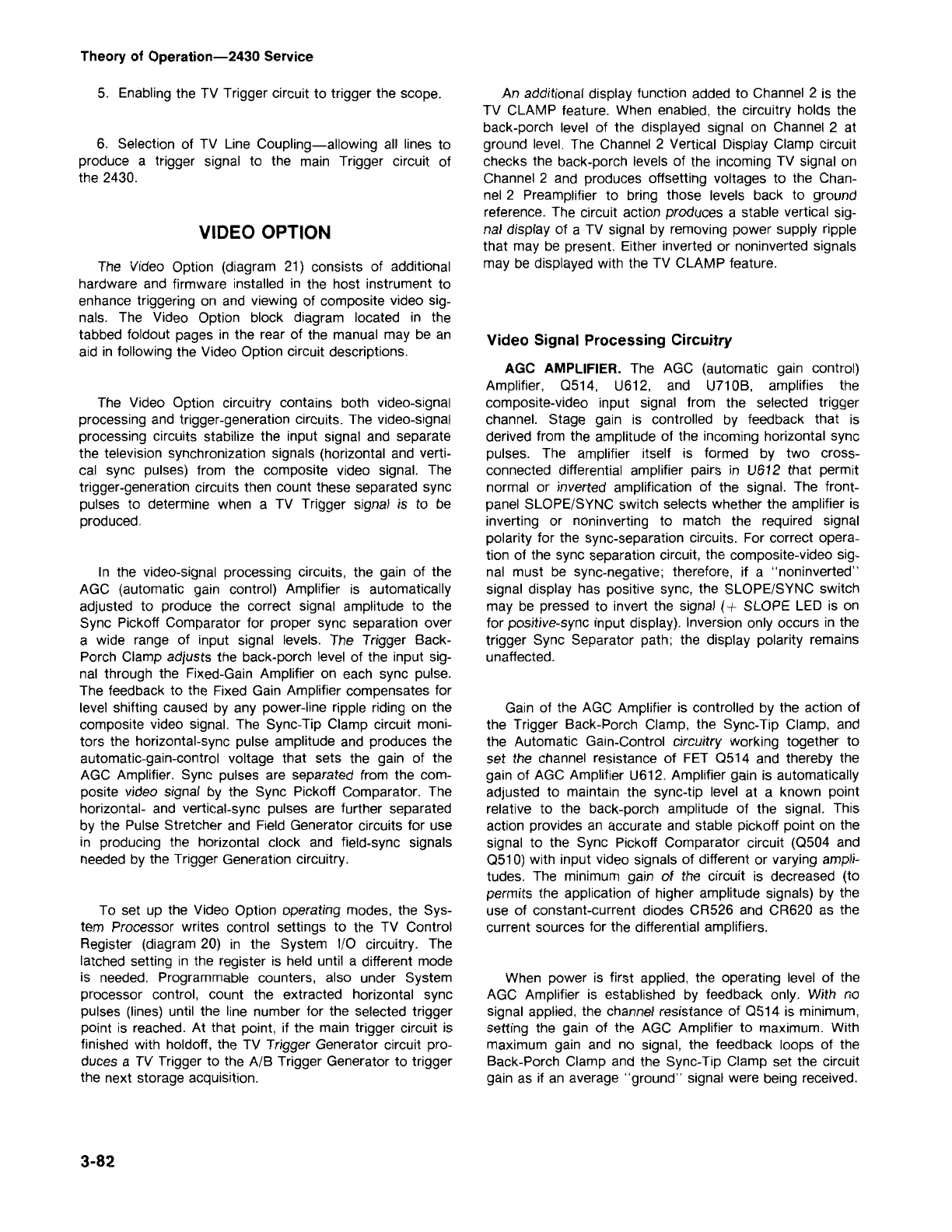When power is first applied, the operating level of the
AGC Amplifier is established by feedback only. With no
signal applied,the channelresistanceof 0514 is minimum,
setting the gain of the AGC Amplifier to maximum. With
maximum gain and no signal, the feedback loops of the
Back-PorchClamp and the Sync-Tip Clamp set the circuit
gain as if an average"ground" signalwere being received.
Gain of the AGC Amplifier is controlled by the action of
the Trigger Back-Porch Clamp, the Sync-Tip Clamp, and
the Automatic Gain-Control circuitry working together to
set the channel resistance of FET 0514 and thereby the
gain of AGC Amplifier U612.Amplifiergain is automatically
adjusted to maintain the sync-tip level at a known point
relative to the back-porch amplitude of the signal. This
action providesan accurate and stable pickoff point on the
signal to the Sync Pickoff Comparator circuit (0504 and
0510) with input video signalsof different or varying ampli-
tudes. The minimum gain of the circuit is decreased (to
permits the application of higher amplitude signals) by the
use of constant-current diodes CR526 and CR620 as the
current sourcesfor the differentialamplifiers.
Video Signal Processing Circuitry
AGe AMPLIFIER.
The AGC (automatic gain control)
Amplifier, 0514, U612, and U710B, amplifies the
composite-video input signal from the selected trigger
channel. Stage gain is controlled by feedback that is
derivedfrom the amplitudeof the incominghorizontalsync
pulses. The amplifier itself is formed by two cross-
connected differential amplifier pairs in U612 that permit
normal or inverted amplification of the signal. The front-
panel SLOPE/SYNCswitch selectswhether the amplifieris
inverting or noninverting to match the required signal
polarity for the sync-separationcircuits. For correct opera-
tion of the sync separationcircuit, the composite-videosig-
nal must be sync-negative; therefore, if a "noninverted"
signal display has positive sync, the SLOPE/SYNCswitch
may be pressed to invert the signal
(+
SLOPE LED is on
for positive-syncinput display).Inversiononly occurs in the
trigger Sync Separator path; the display polarity remains
unaffected.
An additionaldisplay function added to Channel2 is the
TV CLAMP feature. When enabled, the circuitry holds the
back-porch level of the displayed signal on Channel2 at
ground level. The Channel2 Vertical Display Clamp circuit
checks the back-porch levelsof the incomingTV signal on
Channel2 and produces offsetting voltages to the Chan-
nel 2 Preamplifier to bring those levels back to ground
reference.The circuit action produces a stable vertical sig-
nal display of a TV signal by removingpower supply ripple
that may be present. Either inverted or noninvertedsignals
may be displayedwith the TV CLAMP feature.
3-82
To set up the Video Option operating modes, the Sys-
tem Processor writes control settings to the TV Control
Register (diagram20) in the System I/O circuitry. The
latched setting in the register is held until a different mode
is needed. Programmable counters, also under System
processor control, count the extracted horizontal sync
pulses (lines)until the line number for the selected trigger
point is reached.At that point, if the main trigger circuit is
finished with holdoff, the TV Trigger Generator circuit pro-
duces a TV Trigger to the A/B Trigger Generatorto trigger
the next storage acquisition.
In the video-signalprocessing circuits, the gain of the
AGC (automatic gain control) Amplifier is automatically
adjusted to produce the correct signal amplitude to the
Sync Pickoff Comparator for proper sync separation over
a wide range of input signal levels. The Trigger Back-
Porch Clamp adjusts the back-porchlevel of the input sig-
nal through the Fixed-GainAmplifier on each sync pulse.
The feedbackto the Fixed Gain Amplifiercompensatesfor
level shifting caused by any power-lineripple riding on the
composite video signal. The Sync-Tip Clamp circuit moni-
tors the horizontal-syncpulse amplitude and producesthe
automatic-gain-controlvoltage that sets the gain of the
AGC Amplifier. Sync pulses are separated from the com-
posite video signal by the Sync Pickoff Comparator. The
horizontal- and vertical-sync pulses are further separated
by the PulseStretcher and FieldGeneratorcircuits for use
in producing the horizontal clock and field-sync signals
neededby the Trigger Generationcircuitry.
The Video Option circuitry contains both video-signal
processingand trigger-generationcircuits. The video-signal
processing circuits stabilize the input signal and separate
the television synchronizationsignals (horizontal and verti-
cal sync pulses) from the composite video signal. The
trigger-generationcircuits then count these separatedsync
pulses to determine when a TV Trigger signal is to be
produced.
The Video Option (diagram 21) consists of additional
hardware and firmware installed in the hostinstrument to
enhancetriggering on and viewing of composite video sig-
nals. The Video Option block diagram located in the
tabbed foldout pages in the rear of the manual may be an
aid in followingthe Video Option circuit descriptions.
VIDEO OPTION
6. Selection of TV Line Coupling-allowing all lines to
produce a trigger signal to the main Trigger circuit of
the 2430.
5. Enablingthe TV Trigger circuit to trigger the scope.
Theory of Operation-2430 Service

